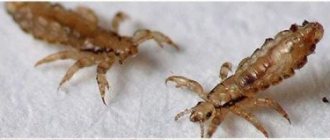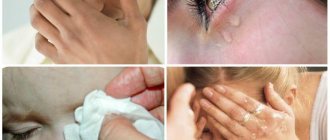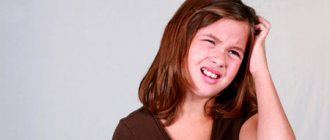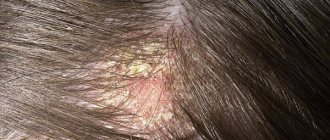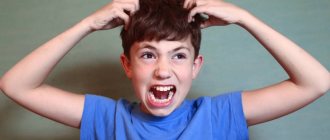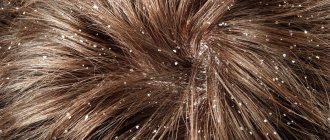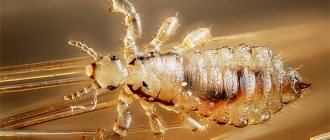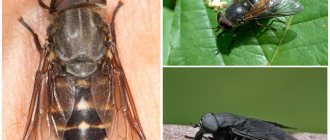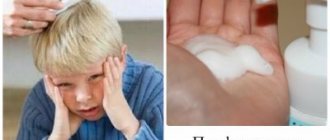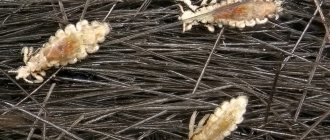What are nits?
The definition of this word will help answer the question of where nits come from. Nits are the eggs of lice - parasites that live exclusively on the hair of humans (or their close relatives - primates).
You need to be able to distinguish between lice and their eggs:
- lice are tiny insects that look like bedbugs and are very mobile;
- Nits are teardrop-shaped white dots attached to the base of the hair. They are also small in size - about 1 mm in length. Painted white or light yellow.
The difference between a dead nit and a living one
A nit is an egg from which a young individual hatches after 5–8 days. During the day, a sexually mature female lays up to 5 of them.
The louse attaches the egg to the hair at a distance of 2.5 cm from the scalp. It is extremely difficult to remove it, since during the process of passing through the fallopian tube of an adult it is treated with an adhesive composition. It is produced by special insect glands. At a distance of 2.5 cm from the body, the temperature regime is ideal for the development of offspring.
It is not difficult to distinguish a living nit from a dead one. A living parasite egg resembles a drop of water up to 1 mm long. It is light and shiny. When pressed with a fingernail, a living egg bursts with a characteristic click.
Dry nits form after the hatching of a young individual or during the treatment of pediculosis with aggressive insecticides. Dead nits look different than live ones. They are also light in color, but lose their characteristic shine. There is no click when pressing.
The appearance and transmission of nits and lice
What causes nits? Nits are not able to spread independently and be transmitted from person to person; their appearance is associated exclusively with the appearance of adult lice on the hair. The adult female lays eggs almost immediately after being on a person's hair.
REFERENCE! A person can acquire lice only through contact with an infected person. Lice that infect domestic animals are not transmitted to humans. It is impossible to become infected with them in nature or through food.
There are not many reasons for the appearance of lice and nits, because these insects have a limited range of movement. They cannot fly, run fast or jump. Also, lice, contrary to popular belief, do not lie dormant under the scalp.
They can only be found on the skin, hair and clothing, and can be transmitted through direct contact with a person, as well as through hygiene and household items of an infected (combs, towels, pillows, fur hats).
Lice can be transmitted when using a pool, sauna, or bath without changing the water between bathers.
It is important to understand that the appearance of lice and nits does not directly depend on hygiene: they can affect both a person with a clean head and a person who has washed his hair for a long time.
Nits and lice developing from them are the cause of a disease such as pediculosis. Pediculosis is characterized by damage to the scalp with severe itching at the sites of insect bites. Lice live not only on the human head. There are also:
- pubic louse, which lives on pubic hair and armpits;
- louse on eyebrows and eyelashes, mainly attributed to childhood lice;
- linen (body) lice that live on the inside of clothes and seams. When wearing such clothing, they can remain on the body and then be transferred to other clothing. There may be cases of transmission of linen lice from one person to another through contact with their clothing. It is reasonable to be wary of linen lice in public transport and other crowded places.
Read more about the types of lice, how they reproduce, and the incubation period on our website.
Also here you will find useful articles about nits:
- how to identify and remove dead nits from hair at home;
- in more detail about what nits look like on human hair;
- how to get rid of nits on long hair - specifics of removal;
- a selection of effective remedies for nits.
Description and types of insects
Lice are small gray-brown insects ranging from 1 to 6 mm in length.
They have a flat body with a small head and chest, the main part of which is occupied by the abdomen. The wings are almost invisible, but there are 6 legs, with the help of which lice move very quickly. Depending on their habitat, there are 3 types of lice:
- head;
- pubic;
- wardrobe
The head louse lives on the scalp, mainly in the occipital region and temples. It has a grayish body measuring 2-3 mm. Short tenacious legs allow the insect to move freely through the hair.
The pubic louse parasitizes the genitals and anus; in rare cases, it can appear in the armpits. The color of its body is light brown, thanks to which the insect is hardly noticeable on human skin.
Body lice are located in cuffs, seams and folds of clothing that come into closest contact with the human body. When hunger strikes, the insect crawls onto the skin and then returns back. Outwardly, they are similar to head lice, have a slightly elongated body of a dirty white color.
Nits are an oval-shaped shell of light yellow color, consisting of 2 parts. The inner part is yolk-like, the outer part is leathery, reminiscent of a cocoon. The female louse lays nits, attaching them to the hair with a special adhesive substance that is resistant to external influences. If you have body lice, lice eggs stick to the fabric.
Photo
Here are some photos on the topic:
Actions upon detection
Lice and nits can be difficult to detect immediately after they appear on the head. A person may not pay attention to the slight discomfort caused by the actions of a small number of lice, because usually single individuals are transmitted.
After appearing on the hair, they lay eggs, and only after a few weeks a sufficiently large population of these insects develops.
REFERENCE! The life cycle of a female louse is 35–40 days. During this time, an adult can lay up to 200 nits. Already on the 15th day of the cycle, the female can already lay eggs. The egg maturation period ranges from 5 to 16 days. Under unfavorable conditions (temperatures below or above 25-27 degrees ), nits can take up to 6 weeks to mature.
The following symptoms may indicate the presence of lice:
- severe itching on the scalp or other scalp;
- excessive irritability and nervousness;
- bite marks, slight swelling, areas of peeling;
- light spots on the head, similar to dandruff. It could be nits.
The following actions can confirm or remove suspicions of lice infestation:
- combing hair along its entire length over a white surface (sheet or towel). Long hair needs to be combed especially carefully. A few lice or nits should fall from the hair when combing;
- hair inspection by one of your relatives and friends;
- self-examination of hair (usually used when a pubic louse is suspected, which is visible to the naked eye).
Life cycle
In its development, the head louse goes through several stages:
- Females lay white eggs - nits. They attach very well to the hair right at the very roots. Sometimes you can see dead nits that are brown in color or empty ones that are light in color and look like dandruff.
- Nits grow from 7 to 9 days. Then it develops - a nymph, the so-called cub.
- After 10-12 days, the nymph turns into a mature louse, which is ready to reproduce and give birth. The louse lives for 28-30 days, and during this time they lay 200-300 eggs.
Ways to fight
If you suspect the presence of lice and nits, do the following:
- purchase specialized shampoos: Veda, Nix, Paranit, Hygia, Pedilin; sprays against lice and nits: Nyuda, Pedikulen-ultra, Para-plus or anti-lice ointments: Benzyl benzoate, Sulfuric and treat the head with them, following the instructions. This will neutralize most of the parasites;
- comb out nits and lice using a special comb or an ordinary comb. It is necessary to comb each strand.
IMPORTANT! This procedure should be repeated regularly, every day for a week or two weeks. It is advisable to comb your hair with a comb twice a day. However, you need to take into account that this will not give a 100% result: lice and nits may remain on the hair.
One way to get rid of nits and lice is to visit a doctor or special sanitary service departments, where they will quickly and accurately remove the parasites.
Pubic lice are removed in the same way. It is advisable to purchase special preparations for pubic lice.
To kill body lice, clothing should be disinfected. This must be done in a steam-formalin chamber. At home, it is enough to boil clothes with the addition of vinegar or anti-lice shampoo, and then wash them.
Effective methods of control
You can get rid of these parasites forever both in special institutions and at home. But considering how many products are available in the pharmacy, you can do it at home.
There are several ways to get rid of this disease.
Shaving the hair from your head is a very easy and effective approach. Fast and safe method. However, it will not suit those who are embarrassed to go out with a shaved head, especially girls who feel sorry for their hair. A good way to get rid of lice in young children.
Special products for removing lice - shampoos, sprays, lotions and creams. A definite plus is hair preservation. Disadvantages - there may be an allergic reaction and itching to some components of the drugs. The principle of use is simple: the product is applied in 2 stages and left on the hair for 3 hours. The second treatment is carried out after 5-7 days.
Combing out lice. You will need a special comb with very fine teeth. Allows you to separate stuck nits from hair and comb out adult nits. A safe, but very time-consuming method that requires extreme care. Typically, the comb is used in conjunction with shampoo or lotion to improve performance.
Folk remedies - oil, kerosene or vinegar. The main thing is to be vigilant and follow safety rules.
- Dilute 9% vinegar (table, apple or wine) with water in a ratio of 1:2. Moisten dry hair with the resulting vinegar solution and put on a plastic cap. Leave for 30-60 minutes, comb out parasites with a comb and rinse hair with water. There is no need to increase the concentration of vinegar, as this can lead to scalp burns.
- Oil hair mask. Mix a glass of any oil with a glass of 9% vinegar. Apply the mixture to dry hair along the entire length and leave for 7-8 hours. Comb out nits and adults, wash your hair with shampoo.
- Dilute kerosene with oil and shampoo in a ratio of 2:2:1, apply to dry hair and leave for 1 hour for children and 2 hours for adults. Afterwards, wash your hair with shampoo and rinse with water and vinegar.
Drugs. An effective and high-quality method. Some medications for children and adults are listed below. They are safe and will not harm the child or your health. Important! Follow the rules specified in the instructions!
Nyuda is a spray containing the excellent agent dimethicone. It is part of the chemical composition of liquid silicone. As a result, it does not poison the lice, but clogs their airways. To remove nits from hair, the kit comes with a special comb.
Medifox is a very powerful remedy. This drug should not be used on children.
Pediculen Ultra is a very affordable medicine from a domestic manufacturer. It is not only able to eliminate lice, but also destroys nits.
Pair Plus - includes 3 powerful insecticides at once and can cure lice in 1 dose.
Elimination of lice and their larvae using a special drug or poisonous folk medicine is usually carried out according to the following points:
- The medicine is applied to the hair in the quantities specified in the instructions itself. Shampoos for wet hair, creams for damp hair and sprays for dry hair.
- Then use a cap (plastic bag) to hold it for the required time.
- Then we wash the medicine off the head and wash the hair with regular shampoo.
- After the procedures, comb out lice and nits with a comb.
Each nit is covered on top with a protective shell that is resistant to moisture and special preparations. For this reason, it is much more difficult to deal with nits than with living adults.
If men and young children have head lice, the easiest way to get rid of the parasites is to completely shave the hair on the head. For aesthetic reasons, this procedure is not suitable for everyone, so there are a fairly large number of other methods of combating nits and lice.
We suggest you read: Can bedbugs live in only one room or sofa?
A female louse that has reached the adult stage is immediately ready to reproduce
Folk remedies
Considered safer for humans than chemicals. The most popular include:
- Lemon or cranberry juice. It contains a large amount of acid, which can destroy the nit shell. Lice with this effect become less mobile. If you wet your hair with juice for several days, then you can easily comb out lice and nits using a comb.
- Onion or garlic. These vegetables contain a caustic substance that has a detrimental effect on parasites. It is necessary to squeeze out the juice of onion or garlic, apply to hair, and keep under a plastic bag for 3-4 hours. Then rinse and comb your hair thoroughly.
- Sunflower and lavender oil. Add a few drops of lavender oil to sunflower oil and apply this mixture to your hair. Cover your head with a plastic bag and keep it there for an hour. The oil film prevents insects from breathing, which leads to their death.
Treatment with folk remedies takes a long time and does not always give positive results.
Similar products for killing lice and nits are special shampoos and solutions for treating hair.
The most effective among them are:
- shampoos “Pedilin”, “Paranit”;
- aerosols “Nuda”, “Para Plus”;
- emulsion "Medifox";
- cream "Nittifor"
Often, medicines come with special combs used to comb out lice and nits. They have metal teeth with special notches. The gap between the teeth is negligible, which allows you to trap nits and lice.
The rules for using a comb are very simple. After treating your hair with special products, you need to divide it into thin strands. Combing is done from roots to ends along the entire length of the hair. To ensure that insects are visible, it is better to perform this procedure over a white cloth.
Using the comb is absolutely safe and has no contraindications. It can also be used for preventive purposes by combing your hair once a week to detect parasites.
To completely get rid of lice and nits, a complex treatment method is most often used, including chemicals and mechanical means. Like any other disease, head lice is easier to prevent than to cure. To do this, it is enough to follow basic rules of personal hygiene.
Folk remedies
The following folk remedies can be used as a preventative and auxiliary remedy to combat parasites: vinegar, kerosene, dichlorvos, hairspray, hair dye, dust soap, essential oils, including tea tree oil, Lobel's cherry infusion, hydrogen peroxide or cranberry juice
For women, you can also dye your hair. They not only poison nits, but also soften their shell, making subsequent mechanical removal of nits easier.
Please note that folk remedies can be harmful if used incorrectly. For example, hydrogen peroxide, vinegar and kerosene can lead to skin burns when used for a long time, and cherry infusion can lead to allergies.
Both when using chemicals (medicines, shampoos) and when using folk remedies, you must take precautions and strictly follow the instructions.
RESULT! Nits can only be transmitted from one person to another. Therefore, you should take precautions: do not use other people’s personal hygiene items, carefully choose a place for swimming, and beware of long stays in crowded places.
However, if infected, you can simply and quickly get rid of parasites using special chemicals and folk remedies.
What to do if parasites appear?
Today there are a huge number of special anti-pediculosis shampoos, sprays and other products that allow you to get rid of the problem of parasites.
The most important thing is not to delay starting treatment. There are some simple tips on how to get rid of nits.
- the most effective way is mechanical. That is, manually examine each strand on the head and, if nits are found, comb it out of the hair. A fine anti-pediculosis comb, which can be purchased at any pharmacy, is suitable for this;
- vinegar. Acetic acid partially dissolves the nit glue and allows you to quickly get rid of the egg. To do this, you need to prepare a solution (2 tablespoons per 200 ml of water), dip your hair in it for a few minutes. Then comb it out;
- Listerine mouthwash. The alcohol included in the composition softens the capsule and glue, making it easier to remove the nit from the hair. Apply it for half an hour, then rinse with warm water and vinegar. It is not recommended to use if there are abrasions or wounds on the scalp;
- hellebore. This is a plant poison that can cause allergies. Hellebore water is rubbed into the scalp for 1-1.5 hours, then washed off;
- cranberry juice dissolves nit glue. It is best to mash the berries, cover your hair with them and hide them under a plastic cap and towel. After approximately three hours, you can rinse with water;
- hair dye. It is effective only if the composition contains hydrogen peroxide;
- exposure to temperatures above 45⁰С. Such temperatures are fatal to nits.
We suggest you read: How to get rid of moths in cereals at home
Also effective folk remedies for the treatment of head lice include: kerosene, dichlorvos, hairspray, essential oils, including tea tree oil, dust and tar soap.
If the above measures do not help, you should consult an infectious disease specialist who will prescribe appropriate treatment for head lice.
A female louse that has reached the adult stage is immediately ready to reproduce. 2 days after fertilization, she lays 4-5 eggs on her hair. The process of their maturation takes from 5 to 15 days, depending on the ambient temperature. The most favorable temperature is considered to be around 30°C. One female can lay from 80 to 150 eggs in her life. Thus, the number of parasites can increase several dozen times in a couple of months.
Reproduction occurs by laying eggs called nits
Using a microscope, you can see that nits resemble translucent drops located at a distance of 1-3 cm from the hair root. At the bottom of the nit there is a fastener that holds it on the hair, and on top there is a kind of cap. The mature larva begins to intensively swallow air. In this case, the gases escaping from the anus push it out. After the young individual emerges, the empty nit remains in the same place.
Having gotten rid of live parasites and destroyed the embryos, you should not expect the dead nits to fall off by themselves. This can take a very long time, and there is no guarantee that they are all non-living. Perhaps there are viable ones left among them and, if overlooked, we can expect the emergence of a new generation of an intolerable parasite. It’s better to start removing them, even by hand.
A dead nit will not fall off on its own. Even clean and well-groomed hair will look untidy if whitish capsules at the roots are visible through it. Be sure to delete!
How to get rid of dead nits? You can remove dead nits using a special comb. Preferably wide. There are many of them available, from conventional to electric. You can purchase any of them at almost any pharmacy. An ordinary comb, due to its structure, will not help much.
It is necessary to follow all the steps correctly, only then will your head become clean and free of lice and their eggs.
- Divide hair into even strands.
- Comb each strand separately.
- Place the treated strand on the side, securing it with a hairpin or clip so that it does not touch the untreated area.
- Scratch over a sink or a cloth.
- Comb thoroughly every day for 10 days.
- Every day during this period, wash your hair with a special product.
- Treat combs, hairpins, brushes, if they have been used - wash with laundry soap and running water.
- Wash fabric, napkins and gloves immediately in hot water (50 degrees) or burn them.
To make it easier to remove the nit from its place, its shell is softened with the help of special anti-pediculosis agents. These can be special pediculicidal shampoos, or sprays against lice and nits: aerosol Para-Plus, Pedilin, emulsion Medilis Malathion, Pediculen-ultra, Paranit, Nyuda, or anti-pediculosis ointments - Benzyl benzoate and Sulfuric.
Before applying chemical antiparasitic agents, read the instructions.
Sometimes, in the fight against the tenacity of nits, time-tested folk remedies for lice and nits are used: cranberry juice, kerosene, vinegar, hellebore water. Sometimes hydrogen peroxide, hairspray, dichlorvos, hair dye, dust soap, and tea tree oil are used.
ATTENTION! Kerosene and vinegar can burn the scalp. Hellebore water can cause an allergic reaction. Peroxide changes the natural color of hair.
Read useful articles about nits on our website:
